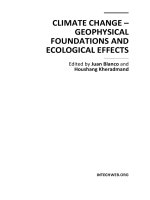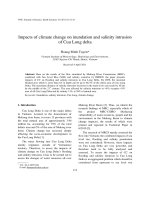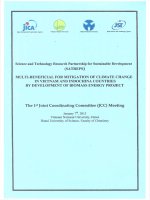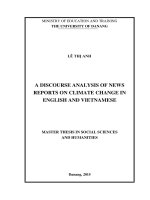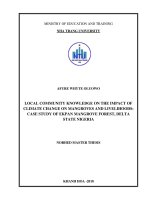Lecture 4 Climate change, Environment issues and Impacts
Bạn đang xem bản rút gọn của tài liệu. Xem và tải ngay bản đầy đủ của tài liệu tại đây (8.25 MB, 42 trang )
Lecture 4
Climate change, Environment issues and Impacts
Lam Thi Thu Suu
CSRD
/>sites/default/files/documents/Vietn
am-EACCSocial.pdf
Vietnam as the top four countries
affected by sea level rise
Mekong delta as one of three
hardest-hit delta regions by
climate change worldwide (IPCC 4th
Assessment Report, 2007)
Sea level
rise (m)
Land lost
(%)
Pop. displaced (%)
# 1.0
# 25
# 20 (3.5 mil.)
# 2.0
# 50
# 75 (14 mil. )
Contribution percentage % of
rivers flow into Vietnam
24,000
(2011)
23.269.316 T
22,000
20,000
18,000
16,000
14,000
12,000
1995.0
1997.0
1999.0
2001.0
2003.0
2005.0
2007.0
2009.0
2011.0
Delta supplies more than 53% of the nation’s rice and crop food, 80% of
the total fish production, and 75% of fruits for domestic and export.
Climate trends
Trends
Dry duration prolonged
Wet duration
Annual mean temperature
Heat waves
Precipitation in critical season
Abnormal rainfall in wet season
Upstream floods
Sedimentation
River bank erosion
Drought
Abnormal strong wind (Whirlwind)
Current impact and Expected impacts
- Upper stream :river banks eroded water
shortage, fire, insects, delayed growth of
trees and plantation, Tiredness and
illness, lost of income
- Middle part: house and vegetable
damage, lost income and lost of
livelihood, low productivity due to salty
soil, flooded, eroded river banks
- Lower stream : death, injures,
infrastructure damage, lost and damage
of rice, fishing gear, lost of land, lack of
water, shrimp farming affected, delayed
fishery processing activities
Vulnerability
- Physical vulnerability : always suffering from
extreme weather (land territory, tropical
monsoon climate and regional climate variation).
- Social –economic vulnerability (poor
infrastructure, lack of insurance system, credit,
knowledge, poor management, irigation,ect)
Who are vulnerable?
- People living along in low deltas
and coastal belts.
- Migrant and poor labor residents
in cities
- Ethnic minority, women, children
and elderly.
The poor are also most at risk
because they have little diversity
in their income sources. They lack
the resources and ability to invest
to absorb climate related risks, or
to recover from extreme events
Xayaburi dam and Don Sahong being
constructed in Lower Mekong river in Laos
Water Conversion Project along the
Mekongs
Discussion
• Watch the video and review the reading “Are
Vietnam’s Delta dying?”
• Discussion : How the Mekong river delta
become???
Hydropower development in VN
Installed capacity mix by fuel types
Import
4.7%
SPP, Renewable
3.2%
Diesel
2.5%
Hydropower
34.8%
Gas Turbine, CCGT
31.4%
Oil thermal
2.7%
Coal thermal
18.5%
Gas thermal
2.2%
Vu Gia Thu Bon River
Thu Bon (10,350
km2),
Vu gia (5,500km2)
Average flow:
400m3/s
Dry season :40 -50
m3/S
Raining season: 2700
m3/S
Hydropower dams in Quang Nam
Dams and plants
1995 – present: > 800 hydropower plants
118 big plants (>30MW ) (49 operating, 47 under construction, 22 planned)
generating 24,893 MW.
Impacts and costs
• Lost of forest
• Lost of bio diversity
• Lost of wildlife and fish
• Dead river (no water, run off)
• Lost of Sediment
• CH4 – green house gas
• Downstream impacts (too dry
and too floody)
• Risks and Resettlement : Big
issues
Risks of leaking and failure
Risks of Earthquake
Damages and worry
• 900 house damaged and borken
• People worry day and night
• People don’t want to work, can’t
sleep
• Enterprise hesitate to invest
• People tend to move out
• People don’t want to invest
People evacuated by dam flush
Problems of dam– induced resetlement
A luoi ressetlement
Land for rice field provided for the
ressetled
Resettlement
• No compensation
money for land, just for
asset on land (100 mil
VND/ avarage)
• 500 m2 for house and
garden
• 5000 m2 – 20.000 m2
forest land
• 500 m2 for rice field

